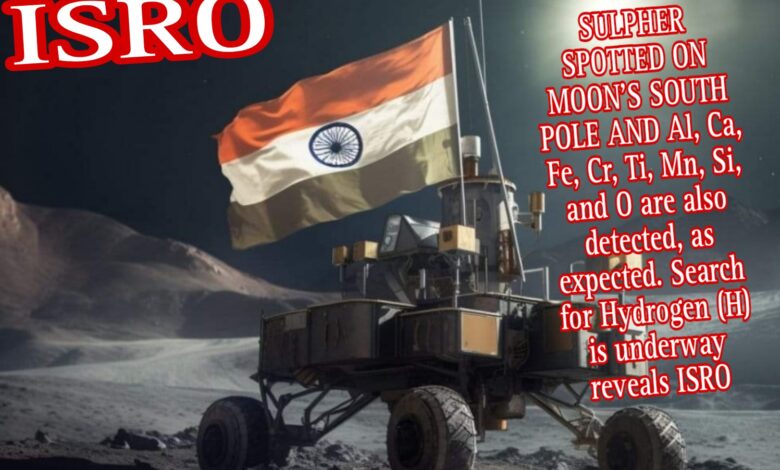SULPHER SPOTTED ON MOON’S SOUTH POLE AND Al, Ca, Fe, Cr, Ti, Mn, Si, and O are also detected, as expected. Search for Hydrogen (H) is underway reveals ISRO

The Indian Space Research Organisation’s Moon vehicle on South Pole Lunar Surface has completed a week in the moon with seven more days remaining. The Chandrayaan 3’s Vikram lander and Pragyan Rover are busy carrying on the in situ scientific experiments on the Moon’s surface on the South Pole having found presence of Sulpher (S) on the lunar Surface of the South Pole through its first ever in situ experiments that are continuing with full vigour and vitality for the eighth day. This encouraging news about Sulpher traces including detection of Al, CA, Fe, Cr, Ti, Mn, Si and Oxygen have undoubtedly given the ISRO scientists lot of optimism about future scientifically possibilities. However, the search for Hydrogen ( H) is underway Incessantly. According to the ISRO disclosure on X, earlier twitter, under the heading CHANDRAYAAN 3 MISSION, the thrilling revelation about Sulpher findings on Moon and other possibilities it is mentioned : IN-SITU Scientific Experiments continue ….. , Laser – Induced Breakdown Spectroscope ( LIBS) instrument on board the Rover unambiguously confirms the presence of Sulphur ( S) in the lunar surface near the South Pole , through first ever IN-SITU measurements. Al, Ca, Fe, Cr, Ti, Mn, Si, and O are also detected, as expected. Search for Hydrogen (H) is underway. LIBS instrument is developed at the Laboratory for Electro-Optics Systems (LEOS)/ISRO, Bengaluru. It may be recalled that on August 27 the Pragyan Rover had come across a four meter crater just three metres away from it but it sensed it in time and charted a new path. On the same day the Pragyan Rover had also measured the temperature profile of the lunar topsoil around the pole via ChaSTE (Chandra’s Surface Thermo physical Experiment) to understand the thermal behaviour of the moon’s surface. It had the temperature probe equipped with a controlled penetration mechanism capable of reaching a depth of 10 cm beneath the surface. The probe was fitted with 10 individual temperature sensors. The graph exhibited on X by ISRO illustrated the temperature variations of the lunar surface/near-surface at various depths, as recorded during the probe’s penetration. This was the first such profile for the lunar south pole. Detailed observations are still underway revealed ISRO on X. The Chandrayaan 3 had travelled a challenging forty day journey from Shriharikota to the Moon’s Southern Pole landing successfully on the South Pole ( the dark side) of the Moon on 23 rd August becoming the first country in the world to land here becoming the fourth country after US, Russia and China. The prime minister Narendra Modi had personally reached Bengaluru from Greece to congratulate the ISRO chairman S. Somanath and his entire dedicated Scientists including high spirited women scientists whose years of hard work and dedication raised the India flag high on the Southern Pole of the moon and the world bringing laurels for India, globally.





